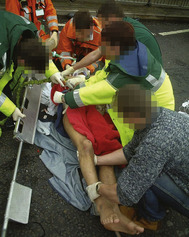CASE 8
 |
Incident
Relevant information
▪ Aircraft: Rotary wing
▪ Ground resources: One land ambulance. Police and Fire & Rescue Services
▪ Retrieval options: Major trauma hospital 15 minutes by road
▪ Other: RSI has been performed by the PHR team due to unconsciousness; the patient is otherwise physiologically stable
Question
8.1 How will you package this patient?
Discussion
8.1 Packaging the patient depends on the mode of transport and nature of illness. Primary trauma patients should be managed in a similar fashion whatever the mode of transport to enhance operational consistency. Minor differences in packaging will be inevitable due to the variable design of ambulances, rotary-wing and fixed-wing aircraft. Even within helicopters, there are multiple design differences that will affect packaging. However, the basic principles should be unchanged.
The main aim of packaging is to minimise movement of the spinal column. Minimal movement of the injured patient will also reduce movement of damaged bones and organs. This will in turn reduce clot disturbance, blood loss and inflammatory cytokine release. Good packaging will also reduce pain and the need for potent analgesics as well as facilitate improved patient flow and early assessment and intervention on reception at the receiving facility.
Extrication boards versus scoop stretchers
Further to the discussion in Case 7, such devices are often referred to as ‘spinal boards’ but the name ‘extrication board’ better explains the role of this device. It is an invaluable tool for removing trapped patients from vehicles while preserving some degree of spinal immobility. However, the board is hard and lying on it for any length of time can lead to pain and even early pressure sores. A better device for transfer is the two-part scoop stretcher. Patients found on extrication boards should be resuscitated in situ but should be transferred to a scoop stretcher for all but the shortest of journeys.
Clothing
As a general rule, patients should be packaged ‘skin to scoop’ meaning all clothing should be removed. Even the toughest motorcycle leathers can be removed with a high-quality pair of trauma shears. Cuts should be made up each arm and leg, across the waist and in a ‘Y’ pattern across the chest. Careful attention to removal of clothes initially will save time and effort later.
< div class='tao-gold-member'>
Only gold members can continue reading. Log In or Register to continue
Stay updated, free articles. Join our Telegram channel

Full access? Get Clinical Tree








